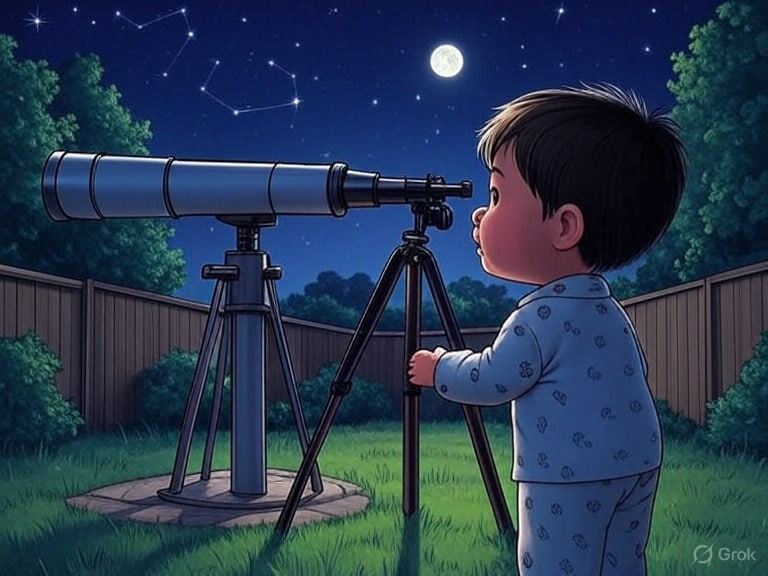Introduction: A Sky Full of Sparkles
Have you ever looked up at the night sky and noticed how the stars seem to dance and sparkle? Sometimes they shine bright, and then suddenly they look dim, almost like they are blinking. We call this effect “twinkling.”
But here’s a secret: stars don’t really twinkle! They are steady, giant balls of burning gas, just like our Sun. So why do we see them twinkle from Earth? Let’s go on a journey through space and atmosphere to find out.
What Are Stars, Really?
Before we understand twinkling, we need to know what stars are.
- Stars are huge balls of hot gases, mostly hydrogen and helium.
- They burn so brightly that their light travels millions or even billions of years to reach us.
- Our Sun is also a star, but because it’s so close, it looks bigger and doesn’t twinkle like the faraway stars.
So, stars are like powerful space lanterns. But something happens to their light before it reaches our eyes.
The Journey of Starlight
Imagine you are shining a torch through a glass of water. The light bends, wiggles, and sometimes even looks broken. That’s because the water moves the light around.
The same thing happens with starlight. It has to travel through the Earth’s atmosphere, which is full of moving air, heat, and tiny particles.
When the starlight passes through these layers:
- It gets bent in different directions.
- Sometimes it looks brighter.
- Sometimes it looks dimmer.
This bending and shaking of light is what makes the stars look like they are twinkling!
Why Doesn’t the Moon or Planets Twinkle?
Now, here’s something interesting: the Moon and planets don’t twinkle like stars. Why?
- Planets look bigger in the sky because they are closer to us.
- Their light is not just one small beam—it’s a larger patch of light.
- Even if the atmosphere shakes their light, it doesn’t look like blinking.
That’s why when you look at Jupiter or Venus, they usually shine steadily compared to the twinkling stars.

The Atmosphere’s Magic Trick
Think of Earth’s atmosphere like a giant invisible blanket made of different layers. These layers are always moving because of winds, heat, and changing weather.
- Hot air rises and cold air sinks.
- Air mixes and swirls around.
- This moving air makes the light from stars wiggle like water ripples in a pond.
That’s why on some nights stars twinkle a lot (when the air is unsteady), and on other nights they twinkle less (when the air is calm).
Why Do Stars Change Colors While Twinkling?
Have you ever noticed stars turning red, blue, or green as they twinkle? This happens because:
- When starlight bends, some colors get stretched more than others.
- Our eyes see those color changes quickly, making the star look like it’s flashing rainbow lights.
It’s like a mini disco party in the sky!
Fun Fact Box 🌟
- If you went into space above Earth’s atmosphere, stars would not twinkle at all.
- Astronauts on the International Space Station see stars as steady points of light.
So twinkling is really an Earth-only magic trick.
How Ancient People Saw Twinkling Stars
Long before telescopes, people noticed stars twinkling and made up amazing stories:
- Some thought stars were campfires of the gods.
- Others believed stars were spirits winking at humans.
- Sailors even used twinkling stars to guide their ships across oceans.
Even though we now know the science, twinkling still makes the night sky feel magical.
Can We Use Twinkling to Learn About Stars?
Yes! Astronomers use special telescopes that can “cancel out” the twinkling effect. This is called adaptive optics. It allows them to see stars clearly and study planets around them.
So even though twinkling makes stars look pretty, scientists try to remove it when they want to discover new worlds.
How You Can Watch Stars Twinkle
Here are some fun activities you can try:
- Lie on the ground in your backyard or balcony and watch stars. Notice how some twinkle more than others.
- Compare planets and stars—see which ones blink and which shine steadily.
- Use a telescope (even a small one) to spot the differences more clearly.
Conclusion: The Sky’s Sparkling Secret
So, why do stars twinkle? It’s because their light has to pass through Earth’s atmosphere, where moving air bends the light in different directions. This makes the stars appear to blink, change color, and sparkle like tiny diamonds.
The truth is, stars themselves shine steadily. But thanks to our wiggly atmosphere, we get to see a magical light show every night.
Next time you look up at the sky, remember—you’re watching a cosmic dance between the stars and our atmosphere!